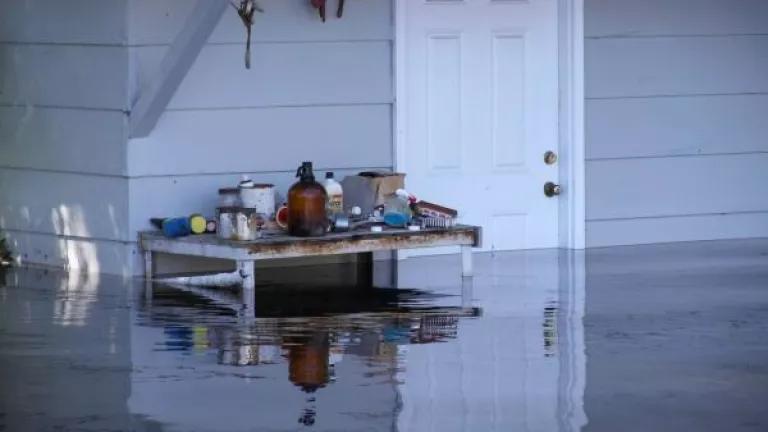Already Living in the Future: NCA4 and Equitable Adaptation

One of the key aspects of the Fourth National Climate Assessment—particularly the chapter on coastal effects—is the word already. “Coastal economies and property are already at risk,” viewers see when they first arrive on the chapter’s website. Reading further, they find the following statements:
The more than 60,000 miles of U.S. roads and bridges in coastal floodplains are already demonstrably vulnerable to extreme storms and hurricanes that cost billions in repairs.
High tide flooding is already forcing some East Coast cities to install costly pump stations to frequently clear floodwaters from the streets.
The effects of the coastal risks posed by a changing climate already are and will continue to be experienced in both intersecting and distinct ways.
To those of us who have the luck and privilege to not yet be personally affected (or at least, not as far as we can tell), climate change may still seem like something that will happen in the future. It’s something to worry about and work to avoid for our children’s or grandchildren’s sake. But for many Americans, especially the most disadvantaged among us, it’s already here.
Vulnerable Americans are on the front lines of climate change
The National Climate Assessment makes it clear that climate change is already—there’s that word again—outpacing our ability to adapt. The “key messages” of the coastal effects chapter lay it out: coastal economies, properties, and environments are already at risk, in ways that intensify and exacerbate social challenges. The question is not whether we will need to adapt, but rather how effectively and equitably we can do so.
This message is not only relevant to the coasts but also to economically vulnerable communities across the United States. The assessment highlights government agencies, communities, and organizations that are taking concrete steps toward adaptation. But it also drives home the point that much more needs to be done. The authors of the assessment write:
The financial resources currently being devoted to adapt to or mitigate coastal climate change impacts are insufficient to meet the projected challenges ahead. Additionally, with the limited and often expensive adaptation opportunities currently under consideration, including elevating properties or constructing seawalls, climate-driven impacts may lead to a great deal of unplanned and undesired community change that is likely to disproportionately impact communities that are already marginalized.
Not only are low-income and minority Americans more likely to already live in flood-prone areas, they are more severely affected by natural disasters, which in turn serves to widen economic inequalities. In addition, our current disaster recovery programs can favor those who have more resources and capacity. We must make adaptation options more equitable, accessible, efficient, and better designed to provide assistance to those most at risk and most in need.
Adaptation options need to be available to everyone
It’s clear that sea levels are already rising and flooding is occurring more frequently. While the National Climate Assessment cannot say exactly how much worse things will get or how fast conditions will worsen (because we don’t know how rapidly emissions will be reduced), it emphasizes that this trend will continue.
Regardless of how much we can curtail greenhouse gas emissions, some amount of change is effectively locked in, and that means coastal communities need to begin making hard choices. The adaptation chapter of the assessment states that “many millions of Americans live in coastal areas threatened by sea level rise; in all but the very lowest sea level rise projections, retreat will become an unavoidable option in some areas of the U.S. coastline.” This may also apply to areas that are some distance inland from the coast but that flood when rivers overflow or when intense rains fall over a large area (as we saw during Hurricanes Florence and Harvey).
The harsh reality is that we cannot afford to construct elaborate flood defenses everywhere, as we have done in cities like New Orleans. In some areas, people and communities will ultimately have no choice about relocating, and certain places will be rendered uninhabitable by chronic flooding and rising seas. For those who are already socially and economically disadvantaged, climate change has truly dire consequences. As a recent article in The Guardian put it: “The Rich Can Afford to Move—What About the Poor?” Those with more resources are better situated to adapt and have access to more options for reducing their risk.
We need to make sure that everyone has options available to them to prepare for the coming changes and—for those already in harm’s way—to deal with the challenges they’re facing now. This includes giving individuals more options for relocating from flood-prone areas and break the cycle of flooding and rebuilding. We can make sure communities that use state or federal money to build infrastructure do so in a way that ensures those assets will function for decades to come. And we can make sure that people have fair and equal access to information about flood risks, allowing them to make more informed choices about where to live.
Big changes are coming, and some are already here. People are already in harm’s way, and transformations of our communities and institutions are already beginning. While we continue to pursue reductions in greenhouse gas emissions, we must also work to make sure adaptation takes place in a way that doesn’t leave anyone behind.




